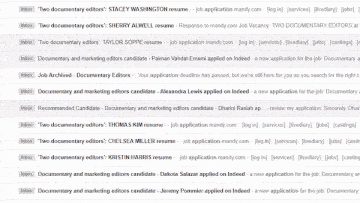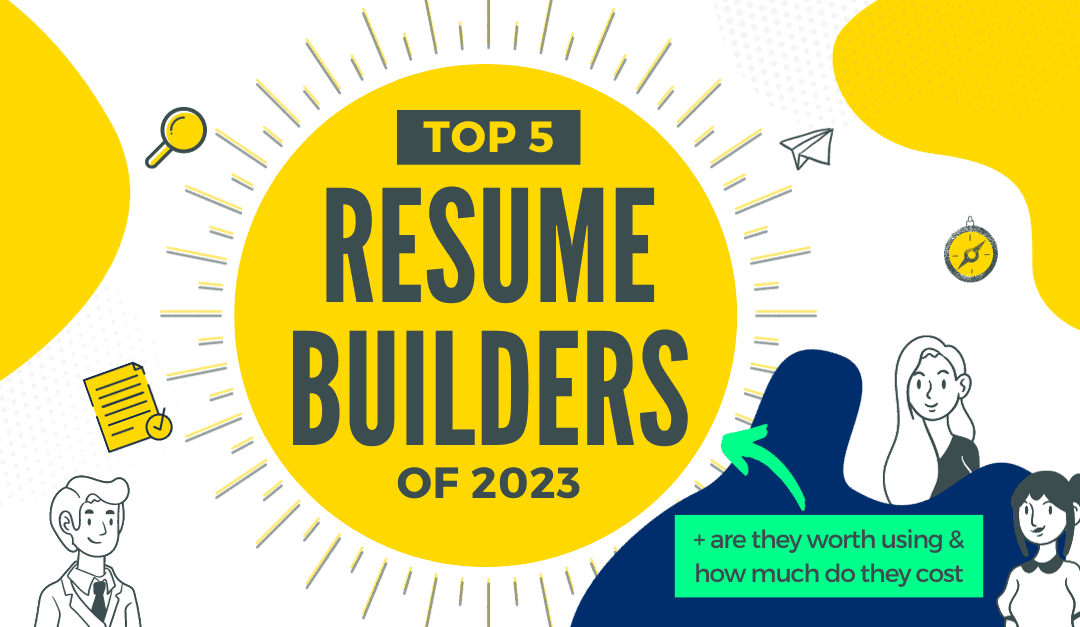
How to Write your Perfect Resume Summary
In this post we’ll go over the 3 essential pieces of a good resume summary, plus we’ll analyze 17 (good and bad) resume summary examples. At the end, I’ll also teach you a unique method for finding your own original resume summary.
For those who are unfamiliar, a resume summary is just a short one sentence summary at the top of a resume. A resume summary is intended to be like a handshake that introduces yourself to the recruiter or hiring manager.

Although deceptively simple, most job candidates mess up their resume summaries and, as a result, often get their resume tossed with all the other generic resumes in a recruiter's inbox.
Similar to your LinkedIn summary, the best resume summary is what will grab a recruiter's attention and make them intrigued to learn more about you.
So, let's first get started with the 3 essential pieces to writing a resume summary that will help you get noticed.
1. Originality
The single most important piece to writing a good resume summary is originality. When I worked as a manager and needed to hire people for my team, I can’t tell you how many times I saw the same summaries showing up in resumes.
This isn’t necessarily the job seekers fault. It’s simply the result of probability.
When I posted our first job opening at my previous agency, we didn’t expect to get many applicants. After all, we were just a small, relatively unknown agency. The job was entry-level and didn’t pay much.
I posted the job opening on Wednesday. When I woke up Thursday morning and checked my email my jaw dropped.
Here’s what my inbox looked like:

Over 122 candidates had applied in less than 24 hours!
The first 5 resumes I read all looked original and different. But, as I kept scanning through more and more resumes, they all started blending together.
There were at least 30 resumes that were colorful and “creative.” There were at least 50 resumes that were black and white and very serious.
Eventually all of them looked similar to all the others and I decided to just pick a few of the best ones that had come in the earliest to be fair.
While there are certain rules on resume formatting that you need to follow, the resume summary is different. The resume summary is your small oasis to show a hiring manager a touch of who you are.
The best way to start off your resume summary is with a few unique descriptors of who you are.
Be very careful here with the words you choose. Most candidates will take about 2 minutes and throw something on the page like:
“Experienced project manager with 5 years experience, self-driven, self-starter, working in the gaming industry for 10 years.”
Don’t do this.
The reason that a resume summary like this isn’t good is because:
a) It doesn’t add anything that can’t already be seen from your resume.
b) Hundreds of other people could write the same summary (and probably have).
Let’s break it down:
“Experienced project manager…”
“Working in the gaming industry for 10 years.”
If you’re actually an experienced project manager who has worked in the gaming industry for 10 years, then your entire resume will show that. There’s no need to waste words saying it if you’ve dedicated an entire page to these facts.
“Self-driven, self-starter.”
While it’s true that these are important qualities, there’s no way for a recruiter to verify these statements. Rather than wasting space writing these throw-away statements, you’ll be much better off proving them during the interview process with a strong story.
Below I’ll show you an exercise that will help you avoid writing generic statements like this, but first let’s go over the other two elements of a good resume summary.
2. Flow
Because a resume summary is usually one sentence (or at least they should be), it’s important for them to have a good flow that’s easy to read. Neuroscience studies have shown that writers use certain techniques that help create flow in the brain.
A good way to figure out if your resume summary has a smooth flow is by reading it out loud. If you want to do an even better test, you can have a friend read it out loud for you.
The Tricycle Rule
In creative writing there is a general rule that lists work best with three consecutive items. We can adapt this tried-and-true writing technique to create better flow in our resume summaries too.
I call this technique the tricycle rule, here’s how it works.
We can think of each descriptor as a wheel on a tricycle. We naturally know that three descriptors (a tricycle) is better than two (a bicycle). We also know that each of the wheels should be about the same size and shape as the other two, otherwise things will feel unbalanced.
The trick with creating good descriptors is to make sure that each descriptor is the same type as the other two. This could be “adjective, adjective, adjective,” or “noun, noun, noun.”
Here’s an example of a good resume summary:
“Award-winning designer, published author, notebook enthusiast.”
Each of the items in this list features:
a) A modifier: award-winning, published, notebook.
b) A noun: designer, author, enthusiast.
Because all three items in the list match, the reader can read through them with a good flow and it creates momentum in the sentence.
A fairly common problem that job candidates make is that they’ll create a three item list, but the items in the list won’t match.
Here’s an example of a bad resume summary list:
“Award-winning designer, self-motivated, with 5 years of experience.”
Do you notice how this list doesn’t flow as smoothly as the first? This is because the items in the list, “adjective+noun, adjective, descriptor,” don’t match each other.
Take a look at your current resume summary. Are your descriptors the same type or do they vary in format?
3. Personality
The last piece to creating the best resume summary is perhaps the most subjective. Related to originality, but not quite the same, personality is the final ingredient in a good resume summary.
This is where you can show a hint of who you are outside of just your day-to-day job duties.
I should emphasize that this piece is SUPER important to make your resume standout from the rest.
Here’s how it works:
As we discussed in the previous post, How to Write a Cover Letter that Matters, the person reading your summary has already read hundreds of resume summaries from previous candidates (most of which are the same). At a certain point they’ve gone into auto-pilot and are just speeding through them.
In order to break a recruiter out of auto-pilot, I like to add a little flourish at the end of my summary to make them take a pause.
Here’s what my best resume summary (that I still use today) is:
“Content wizard, digital marketer, writer, worked at Emmy-award winning production studio, beat Mark Zuckerberg at hockey.”
The last piece about Mark Zuckerberg has absolutely nothing to do with the job I’m applying for, but it’s a fun fact that always gets remembered.
Interestingly enough, this little snippet has also helped me during my interviews. Very often recruiters will start interviewing me with, “so before we begin, tell me how you beat Mark Zuckerberg at hockey!”
It immediately breaks us out of the formality of the interview process and opens up a more casual and productive conversation.
When you’re trying to think of your own personality addendum, try to think of something interesting or important to you.
Some examples I’ve seen work well for other candidates are:
“…father of 3 energetic young girls.”
“…with a mountain climbing addiction.”
“…and theater aficionado.”
“…expert at getting AirBnB discounts.”
This piece of the resume summary should serve as an exclamation point at the end of your summary, so it should actually go against the Tricycle Rule. After all, we want this to stand out, not blend it.
Alright, those are the three essentials to writing a good resume summary. Now, let’s take a look at a few examples of good resume summaries and an exercise you can use for generating your own.

Good and Bad Resume Summary Examples
First, let’s take a look at a few types of resume summaries that should be avoided so we see what NOT to do:
“Seasoned marketer with 5+ years of experience working in SaaS, startups, and tech.”
Comments: There’s nothing wrong with this summary, but it also doesn’t add any additional value to the resume.
“Experienced project manager certified in Agile and Scrum methodologies. Self-starter, value-driven, with a passion for the aerospace industry.”
Comments: This resume summary has good flow, but the certifications belong in the “Skills” section of your resume, not the summary. “Self-starter” and “value-driven” could be written by any other candidates (and often are) so they aren’t very original.
“Mission-driven, detail-oriented engineer working in the petrochemical industry for over a decade with 4 years of management experience.”
Comments: “Mission-driven, detail-oriented” are also generic descriptions and actually distract from the important information here. A cleaner revision could be: “Engineer dedicated to the petrochemical industry for over a decade with 4 years of management experience.”
“Friendly and customer-focused retail associate. Detail-oriented, self-disciplined, and organized with strong ability to multi-task.
Comments: This is a difficult position to write a headline for because most of the skills are soft skills and not easily demonstrable. In this case, it would be better to remove the resume summary altogether or write something non-related to the job.
Hopefully after reading the resume summaries above, you’ll have noticed how similar they can seem if someone is reading a lot of them.
Let’s take a look at some examples of good resume summaries:
“Designer, creator, graphic artist, founder of the Austin Arts Collective, avid Stefan Sagmeister enthusiast.”
“Calm, curious, and courteous, non-profit founder, voted most handsome project foreman.”
“Marketer, researcher, optimization junkie, named “Marketo All-Star” in 2019, stepped on Larry Page’s toes.”
“Compassionate leader, top executive, builder of teams, obsessively organized and curious to solve big problems.”
“Problem solver, systems thinker, process pundit, founding member of the Ruby on Rails community, adored puzzle master.”
“Film student, Coach at AYSO, President of the debate club, graduating from USC this summer.”
Even though these resume summaries are for pretty average jobs, you can see that having an “average job” doesn’t mean you need to have an average summary.
The trick to writing a great resume summary is avoiding the cliche words that most people will use to describe that job.
A few words and phrases to avoid in particular are:
Experienced
Self-driven
Mission-driven
Detail-oriented
Professional
Looking for a job in…
Open to opportunities in…
The Resume Summary Exercise
A good way for finding your best resume summary is by going through the exercise of writing unoriginal resume summaries first. It’s usually hard to think of something “creative” off the top of your head. Instead, try the following:
Write 5 unoriginal resume summaries that describe your job and who you are. Don’t worry about making them sound good, just get all the standard phrases you would use to describe your work out on paper.
Pause here and write them first before continuing below.
Now, look for some of the stronger words from all 5 summaries and try adding some creative descriptors to them.
For example:
Standard: marketer, writer, SEO expert.
With creative descriptors: Data-driven marketer, customer-centric writer, SEO junkie.
After you’ve added all your creative descriptors, look through all 5 sets of summaries and pick and choose the ones that you feel represent you best.
Finally, tweak the wording so that you create good flow and so that you finish with a punchy and thought provoking ending.
Writing a strong resume summary is tough, but it can have some pretty incredible effects on your job search. Paired with a clean template and good bullet points, it can accelerate your job search tremendously, so don't give up. Take your time and write a resume summary you're proud of. It'll be worth it 🙂
Read more resume and interview best practices on The GHYC Blog.
More from the blog:

Best Resume Builders of 2023 (Pros & Cons + Prices)
Modern resume builders use AI, ATS-friendly templates, and active recommendations to help you build your perfect resume faster than ever before. In this post we’ve rounded up the 5 best resume builders of 2023.
How to Beat the ATS in 25 Minutes | The Ultimate Guide
In this guide I’ll show you how to beat the ats (applicant tracking system), plus I’ll give you 2 ATS-friendly resume templates and a free tool to test if your resume is ATS-friendly.
Accelerate your career with a course!
Tired of waiting to hear back from hiring managers? Speed up your job search with one of our accelerated courses. Learn how to optimize your resume, improve your LinkedIn, and nail your interviews to get hired within weeks!
Bogdan Zlatkov is the Founder of GHYC and author of "The Ultimate Guide to Job Hunting", ranked #1 on Google. He has been featured in the Wall Street Journal, Fast Company, HR Dive, and more. At GHYC, Bogdan creates job search courses & tools by working with award-winning career coaches, best-selling authors, and Forbes-Council members. Prior to GHYC, Bogdan led the content programs at LinkedIn Learning.